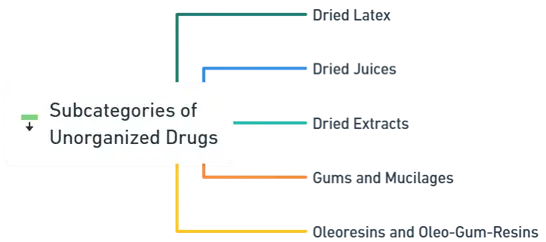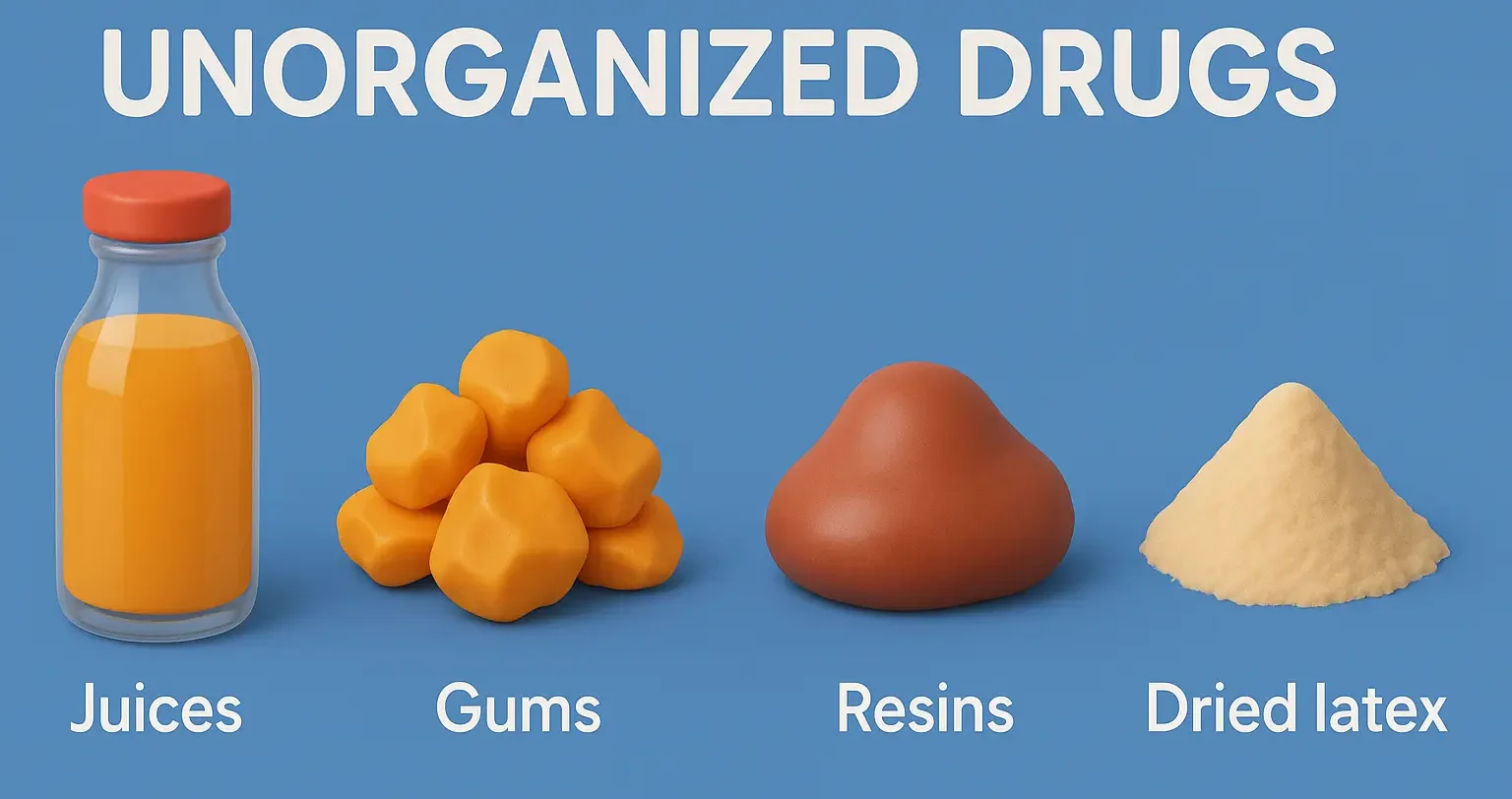- Unorganized drugs are derived from the non-structural components of plants or organisms.
- These substances are typically exudates, secretions, or other plant-derived materials that do not maintain the organized structure of the source.
- They are usually obtained through extraction processes involving solvents and may require further purification to isolate active constituents.

Subcategories of Unorganized Drugs:
1. Dried Latex:
- Definition: A milky fluid found in certain plants, composed of various proteins, alkaloids, and other compounds.
- Sources: Hevea brasiliensis (rubber tree), Ficus elastica (rubber fig).
- Uses:
- Natural Rubber: Used in manufacturing various products like gloves, tires, and balloons.
- Medicinal Applications: Contains compounds with antimicrobial and anti-inflammatory properties.
2. Dried Juices:
- Definition: Concentrated liquid exudates obtained from plants, which are then dried to remove water content.
- Sources: Various plants that exude sap or juice when cut or damaged.
- Uses:
- Medicinal Extracts: Utilized in traditional remedies for their therapeutic properties.
- Flavorings: Used in the food and beverage industry for natural flavors.
Advertisements
3. Dried Extracts:
- Definition: Concentrated forms of plant extracts obtained by removing the solvent, resulting in a dry powder or solid.
- Sources: Leaves, roots, bark, seeds, and other plant parts.
- Uses:
- Pharmaceutical Preparations: Standardized extracts used in medications and supplements.
- Cosmetics: Incorporated into skincare products for their active ingredients.
4. Gums and Mucilages:
- Gums:
- Definition: Soluble, viscous substances exuded by plants, primarily composed of polysaccharides.
- Sources: Acacia senegal (gum arabic), Guar (Cyamopsis tetragonoloba).
- Uses:
- Emulsifiers and Stabilizers: Used in food products, pharmaceuticals, and cosmetics.
- Thickening Agents: Provide texture and consistency in various formulations.
- Mucilages:
- Definition: Gel-like substances derived from plant tissues, rich in polysaccharides.
- Sources: Plantago ovata (psyllium), Aloe vera.
- Uses:
- Laxatives: Promote bowel movements by retaining water in the intestines.
- Soothing Agents: Used in treatments for irritated mucous membranes.
5. Oleoresins and Oleo-Gum-Resins:
- Oleoresins:
- Definition: Natural mixtures of essential oils and resin acids extracted from plants.
- Sources: Piper nigrum (black pepper), Pimenta dioica (allspice).
- Uses:
- Flavorings and Fragrances: Used in the food industry and perfumery.
- Medicinal Applications: Possess antimicrobial and anti-inflammatory properties.
- Oleo-Gum-Resins:
- Definition: Complex mixtures containing essential oils, gums, and resins.
- Sources: Commiphora myrrha (myrrh), Boswellia serrata (frankincense).
- Uses:
- Traditional Medicine: Used for their antiseptic and healing properties.
- Aromatherapy: Incorporated into essential oil blends for therapeutic benefits.
Extraction and Processing:
- Unorganized drugs typically require solvent extraction to isolate the desired components. Common solvents include water, ethanol, methanol, and chloroform. The extraction process may involve:
- Percolation: Passing solvent through the plant material to extract soluble constituents.
- Maceration: Soaking plant material in solvent at room temperature.
- Distillation: Separating volatile components, especially for essential oils.
Click Here to Watch the Best Pharma Videos
Advertisements

